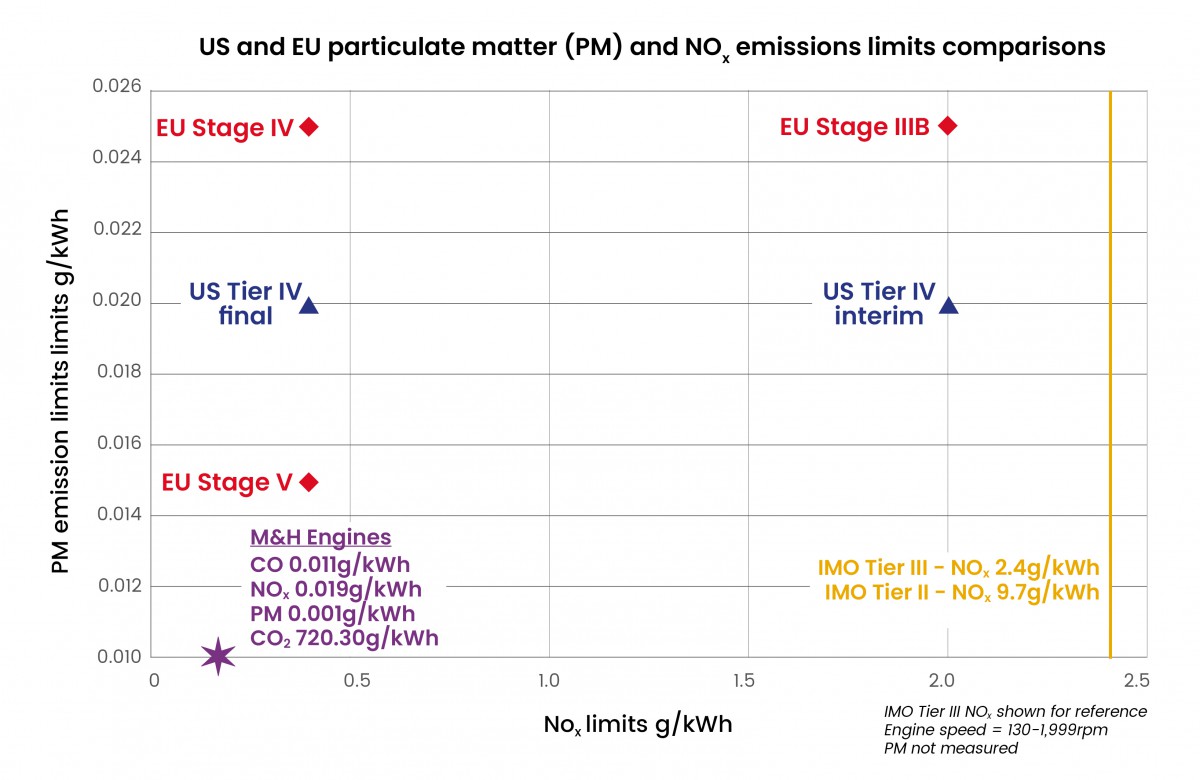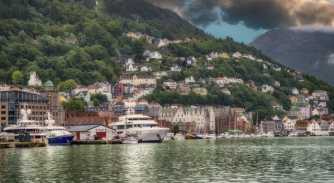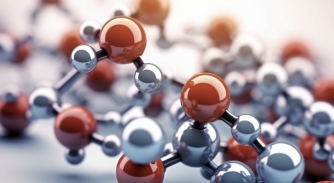Traditional engines, lower emissions
How a new Stage V marine engine provides significant emissions reductions despite being a typical diesel engine…
Internal combustion engines (ICE), particularly diesel engines, are traditionally high emitters. However, with tightening regulations and increasing environmental pressures, companies are being driven to innovate. M&H Engines’ latest range of diesel engines exemplifies this evolution. These engines, while still ICEs, have been engineered to significantly reduce emissions. Barry McCooey, Managing Director of M&H Engines, explains, “We started out in 2017 to build the world’s cleanest marine engine”, which is what M&H claims it has now achieved with the development of its latest M&H Stage V marine engines.
As shown in the graph below, the M&H Stage V engine is well below the NOx and particulate matter emissions requirements as set out by both the multiple stages of the EU’s non-road mobile machinery regulations and the most stringent tiers of the US emission standards for non-road diesel engines, and is even more significantly below the less restrictive IMO Tier III NOx emissions.

To achieve this significant reduction, M&H went into development with the attitude of “let’s look at all the best technology available in all the industries and find the best products and best solutions for us”, says McCooey.
There are a few different aspects of the design of these engines that allow for decreased engine emissions.
One of these is the ability to keep the exhaust gas temperatures high while maintaining a surface temperature of under 220 degrees Celsius, compliant with the IMO SOLAS requirement. The higher temperature enables more efficient post-combustion treatment to reduce the harmful elements in the exhaust, and is being achieved through heat shielding and other patented design aspects.
A bigger difference from other typical ICE diesel engines is the power and torque characteristics of the engine. McCooey explains that this facilitates choosing the right engine for the job, providing engine optimisation through correct engine operation, leading to better fuel consumption and reduced emissions.
The different power curve is best demonstrated by comparing a M&H 317kW (425hp) engine to a John Deere Stage 3a / EPA Tier III, 410kW (550hp) marine engine, which shows a few advantages. While having 125hp less rated power, the M&H engine provides more usable power up to 2,200rpm and more torque up to 1,700rpm. After these points, the Tier III engine matches the power and can provide slightly more torque. However, the increase in power is at the cost of burning more fuel – 4 l/h more at 2,200rpm and 30 l/h for the extra 300rpm – making the M&H engine preferable at medium and lower speeds. A shift in thinking will be required away from aiming for top speeds that will rarely be used.
Alongside the fuel efficiency this characteristic can provide, it also means the potential for a smaller, less heavy engine on board, which can offer more design freedom.
Alongside these fundamental differences in the engine that improve its output, leading to the significant reductions seen in the graph, there are additional actions that could be implemented on other ICEs. A typical addition is that of AdBlue or urea to reduce the NOx emissions from the engine even further. While
urea has environmental issues, such as being associated with its production and its potential to contaminate the environment, the M&H engine has one of the lowest AdBlue consumptions on the market.
A further addition recommended for use by McCooey is Super Lubrication Ltd’s Mechanical Treatment System (MTS). Rather than a chemical reaction, this treatment reduces the friction within the engine, gearbox and other mechanical elements. This reduced friction has multiple benefits. Primarily, it will improve the engine efficiency as less fuel is needed to overcome the friction to achieve the same results. In tests using M&H marine engines we have seen fuel reductions of 10 per cent and a reduction in emissions due to the reduced fuel burn.
“We future-proof our customers for the next two or three emissions regulations.”
From Super Lubrication Ltd’s testing on a Princess S72 yacht with twin V12 MAN diesel engines, the fuel savings proved to be around 10 per cent, with emissions 10 per cent lower by default. Reduced wear also means increasing the service life of the engine and reducing the need for engine maintenance. There will also be noise reduction from the smoother operation.
The final product recommended by M&H to be able to achieve the maximum impact reduction is the use of the synthetic, carbon-neutral diesel fuel C16, which is produced using carbon capture, but has the same density and performance as typical diesel and contains no sulphur or other chemical agents found in diesel fuel.
While this doesn’t change the direct emissions associated with the vessel, the carbon used in its production should equate to the amount being captured for its production, hence being net zero, as well as ideally being produced using renewable energy, thus reducing its associated emissions compared to typical diesel. This synthetic diesel can entirely replace or be blended with regular diesel or other diesels such as biodiesel.
While biofuel is still more environmentally friendly and more circular, its lower potency can mean larger fuel tanks/more refuelling. The other environmental advantage, McCooey explains, is that C16 will entirely break down non-toxically in seawater. He also stated how this fuel can be produced in a scalable and local manner as it doesn’t require large amounts of space for the processes, and the main demands are suitable electrical power, water (to be split into hydrogen and oxygen) and captured carbon.
McCooey hopes to develop a consortium to produce this fuel in bulk, as it is capable of providing both carbon capture and fuel to areas and corporations who build these production facilities, potentially relieving marinas from reliance on the national grid.
This fuel treatment echoes the M&H engine in terms of it being an alternative solution that isn’t so different compared to the typical less sustainable version but still provides significant environmental impact reductions. Other more recognised and familiar environmentally friendly propulsion options receive more attention, focus and development as people look to gain their environmental savings. While this is an appropriate development for many, in some cases, it isn’t suitable to the vessel or location of operation, or in other situations where there could be increased negative impact due to the associated emissions in the production and transport of the fuels and supporting infrastructure.
These extremely low-impact diesel engines are a great middle ground which can provide environmental savings. However, this will be reliant on people understanding that while it is a diesel engine, that doesn’t automatically rule it out as a solution for reduced emissions. This is where McCooey feels that the key to adoption is “education, education, education”, as he says that M&H have presented their engine range to the market for three years and it’s only this year that it’s gained traction and is going somewhere, as people finally understand and see the benefits to be gained.
McCooey says the maritime industry is “30 plus years behind on-road and off-road technology”, but still foresees that, eventually, other engine manufacturers will catch up with this type of technology. MCooey theorises it has taken this long due to the attitude within the maritime industry of, as he summarises it, “We’ve always done it that way”, leading to a lack of change and development. However, from experience, he says superyachts have been more willing to change, but only once understood the savings to be made have been understood.
The benefits could incentivise many to install these low-emission engines and develop similar models. In M&H Engines’ mission to achieve the cleanest engine in the world, their engines have not only met but significantly exceeded multiple emissions regulations, such as IMO Tier III, NRMM and California Air Resources Board’s Tier IV emissions limits. As McCooey says, “We future-proof our customers for the next two or three emissions regulations”, meaning that those adopting low-emissions solutions such as these will avoid more changes in order to be compliant with future regulations or the penalties that could apply from non-compliance.
The drop-in-ability of the M&H engine – and the need to meet future emissions limits – means that it could well be a more favourable method for reducing emissions. If it was adopted during superyacht refits, the cumulative impact reduction potential would lead to a significant amount of emissions reductions during subsequent operations.
As all sustainability options, these engines won’t be the perfect solution and, in some cases, the other more environmentally friendly options will still be preferable, but the opportunity to implement them on those less willing to change design while still achieving reductions seems one worth taking for many.
NEW: Sign up for SuperyachtNewsweek!
Get the latest weekly news, in-depth reports, intelligence, and strategic insights, delivered directly from The Superyacht Group's editors and market analysts.
Stay at the forefront of the superyacht industry with SuperyachtNewsweek
Click here to become part of The Superyacht Group community, and join us in our mission to make this industry accessible to all, and prosperous for the long-term. We are offering access to the superyacht industry’s most comprehensive and longstanding archive of business-critical information, as well as a comprehensive, real-time superyacht fleet database, for just £10 per month, because we are One Industry with One Mission. Sign up here.
Related news

YETI: Five Years On
Feadship reflects on five years of Water Revolution Foundation’s transformative Yacht Environmental Transparency Index tool
Technology

Incentivising emissions reductions
Cruise ships visiting Bergen and reporting to the Environmental Port Index (EPI) can see their port fees reduced
Crew

Don’t be left high and dry
Nigel Marrison, founder of Blue ESG, says how we tackle global-emissions goals will determine the very future of superyachts
Crew

NOx and SOx
They may be an easy rhyming pair, but why are these two chemicals such an issue for the industry and the environment?
Technology
Related news
YETI: Five Years On
2 years ago
Incentivising emissions reductions
2 years ago
Don’t be left high and dry
2 years ago
NOx and SOx
3 years ago
NEW: Sign up for
SuperyachtNewsweek!
Get the latest weekly news, in-depth reports, intelligence, and strategic insights, delivered directly from The Superyacht Group's editors and market analysts.
Stay at the forefront of the superyacht industry with SuperyachtNewsweek



